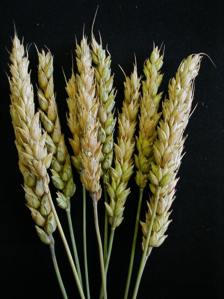Diseases
Fusarium spp. - Fusarium head blight.
Taxonomic position.
Scab (also known as head blight, FHB) is caused by several fungi of the genus Fusarium. The study of Fusarium species on cereals in Russia has revealed 19 species. The principal pathogens are Fusarium graminearum, F. culmorum, F. avenaceum, F. poae, F. sporotrichioides. Fusarium spp. belong to imperfect fungi of the class Deuteromycetes, order Moniliales, family Tuberculariaceae, genus Fusarium. Teleomorph stages are not known for all Fusarium fungi, but they are all related to the sections Gibberella, Nectria of the order Hypocreales.Biological group.
Hemybiotrophic parasites.Morphology and biology.
All small grain cereals may be affected by this disease. Within 7 to 10 days after infection the disease symptoms occur on attacked spikelets as salmon pink masses of conidia. Towards the end of vegetation the black globular perithecia are formed on damaged heads. All Fusarium species have one taxonomic feature in general, i.e., production of distinctly shaped macroconidia (20-70 microns) with different number of septae. Some species produce microconidia (to 10 microns in size) and thick-walled chlamydospores (about 20 microns in diameter). The complex of features combined with other primary and secondary characters of fungi composes the basis for the classical approach to Fusarium taxonomy. Abundant spore production occurs on diseased tissue. Spores are spread by wind, water, cultivation and through infected seeds. The chlamydospores can survive in the soil for many years. The fungi over-winter also by mycelia, chlamydospores and perithecia on infected plant debris and seeds. Both the ascospores and conidia are capable of producing infection if they land on a head of cereal during, or soon after, the flowering period. The spores germinate in a water film and invade the flower parts first, frequently spreading to glumes and other parts of head. The conidia are carried by wind to the heads of other cereal and grass plants, producing new secondary infections. The process repeats as long as the spikelets are susceptible. Ascospores are usually produced too late in the season to function as a secondary inoculum, but they survive on crop residues and may inoculate plants in the next vegetation period.Distribution.
The disease occurs in most wheat growing areas. For the last 10-15 years Fusarium head blight of cereals has been very widely spread in Russia. In this country FHB epidemics occur very often in the North Caucasus and the Far East. In the central and northwestern parts of Russia, at the Ural, in Baltic countries, southwest Ukraine, and Byelorussia this disease occurs sporadically, and is usually associated with years when suitable wet and warm weather conditions occur. It is too dry for scab development in Middle Asia and Kazakhstan.Ecology.
The infection is favored by warm and humid weather during and after heading. In regions with dry weather during this period FHB has no vital importance.Economic significance.
Fusarium species cause considerable damage to cereals. Severe rates of infection can cause yield losses to be more than 20-50%. Damaged wheat seeds are generally very lightweight, having significant reduction of grain quality. Such seeds lack vitality or cause seedling blight. While growing in scabbed seeds, Fusarium fungi produce toxic compounds (mycotoxins) that are harmful to human and animal health. The mycotoxins remain stable for years in stored grain. Regarding scab control, the following actions are used. Small grains and corn rotation with at least one-year break in cultivation. Sowing of adapted wheat varieties, using fertile, well-prepared seedbeds. No highly resistant varieties of wheat are available, but some varieties are tolerant to disease. Proper seed treatment controls seedling damage but does not prevent head-blight development. The fungicide spraying of plants does not significantly suppress disease harmfulness. Complete plowing of crop residues in soil reduces head-blight infections. Keeping grain at a humidity of less than 14% prevents fungus growth and possible production of additional mycotoxins.Reference citations:
Levitin M., Ivashchenko V., Shipilova N., Gagkaeva T. 2000. Fusarium head blight of the cereal crops in Russia. - Plant Protection, 51, 231-232, 111-122 (in Russian).Shipilova N., Gagkaeva T. 1992. Fusarium head blight in cereal crops in the North-western region of Russia. - Zashchita rastenii, 11, 7-8 (in Russian).
Sokolov M.S. 1992. Studies on epiphytotiology and toxicogenesis of wheat head blight carried out by the North-Caucasian Research Institute of Phytopathology. Abstracts of Conf. Fusarium diseases of cereals. - Krasnodar, 4-7 (in Russian).
© Gagkaeva T.Yu.


